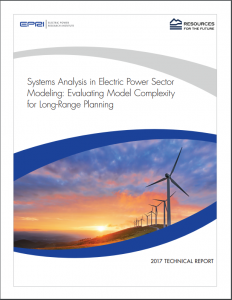Full Title: Systems Analysis in Electric Power Sector Modeling: Evaluating Model Complexity for Long-Range Planning
Author(s):
Publisher(s): Electric Power Research Institute (EPRI) and Resources for the Future (RFF)
Publication Date: October 1, 2017
Full Text: Download Resource
Description (excerpt):
The literature review (Santen, et al., 2017) that preceded this report explains that “systems analysis” approaches to electric sector modeling aim to improve models’ representation of one or more kinds of complexity to support better decision-making. Such approaches are typically aimed at reducing costs, preventing system crises, avoiding unintended consequences, or improving other outcomes. However, there is often a tension between the complexity of a systems analysis approach and the need for simplicity to keep models computationally tractable and practically manageable within a project’s resource constraints. As a result, long-range models of electric sector capacity planning and dispatch require modelers to balance appropriate levels of temporal, spatial, and technical complexity with computational demands. Wellinformed decisions in this balancing act can be important, because simplified representations of the power system may materially impact conclusions drawn from modeling exercises. For instance, they may lead to under- or overestimation of policy compliance costs or to suboptimal decision support about capacity investments.
The objective of this report is to test and examine the benefits of alternate approaches in four key systems analysis areas: temporal resolution, spatial resolution, representation of end use, and representation of uncertainty. The analysis calculates and examines potential impacts of using simplified models and methodologies in these areas, using intra-model comparison exercises with two U.S. capacity planning and analysis models: EPRI’s US-REGEN and RFF’s E4ST. The broader goal is to support more prudent and systematic consideration of model simplifications and tradeoffs between appropriate levels of temporal, spatial, and technical resolution. On one hand, these analyses illustrate how simplifications of system features can lead to unrealistic evaluations of the effects of changes in technologies, polices, and markets.
On the other hand, specific applications merit different tradeoffs and considerations in selecting an appropriate analysis framework, which requires modeler judgment and a thorough understanding of the decision context. This report offers insights to modelers assessing these tradeoffs and to consumers of model results as they evaluate outputs. The experiments in this report underscore how the effects of particular model simplifications can vary substantially based on regulatory and market conditions as well as other model simplifications.
